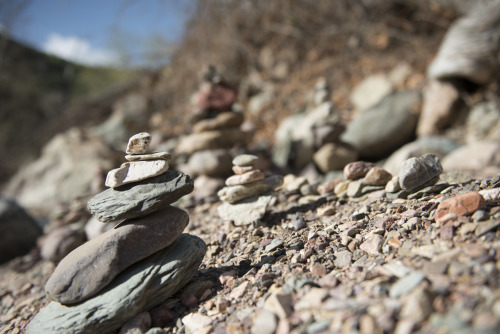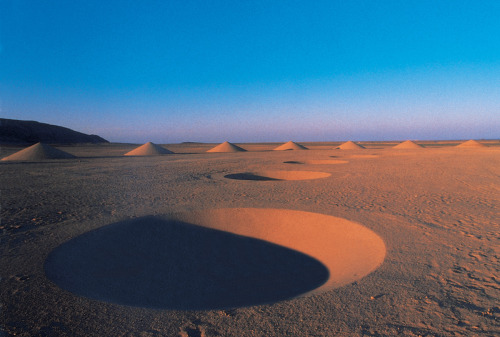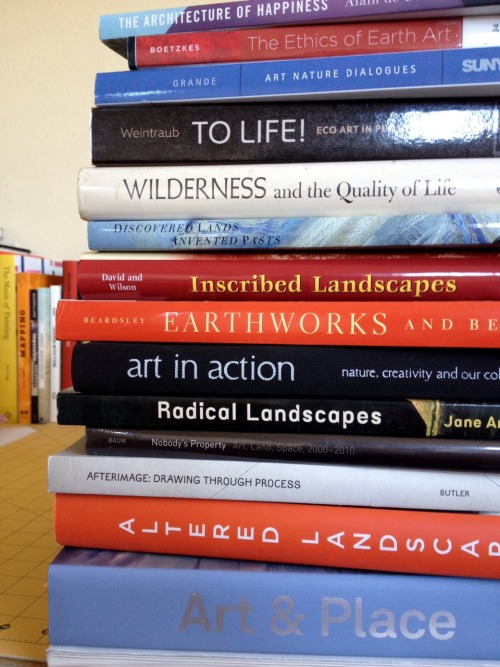|
ABOUT DANIELLE FOUSHEE
I am an artist. This website features my work and highlights some of the varied
Showing posts with label Conservation. Show all posts
Showing posts with label Conservation. Show all posts
Sunday, March 30, 2014
Signal Fire Residency: Cairn Village
Labels:
Arizona,
Conservation,
Danielle Foushee,
Intervention,
Landscape,
Nature,
Process,
Sculpture
Saturday, March 8, 2014
Inspiring Artist: Danae Stratou
| ||||||||||||||
Labels:
Conservation,
Inspiring Artist,
Intervention,
Landscape,
Nature,
Public Art
Saturday, January 18, 2014
Monday, October 5, 2009
Edward Burtynsky Documents Industrial Impacts & Pollution
From time to time, I find images that tear at my soul in their depiction of the devastating effects of our industrialized civilization on the earth. These scars on the surface are only a hint at the destruction that flows from their epicenters. From the displacement of wildlife to the poisoning of groundwater, our consumer lifestyles have a dramatic impact on the planet. See my other posts about mining and its impacts: Amazing Aerials by Alexander Heilner and Strip Mining Conundrum.
Check out these images by Edward Burtynsky. Nicholas Metivier Gallery describes his work here: “Edward Burtynsky’s large-scale colour photographs reveal the many facets of nature as it is transformed through human industry. Exquisitely detailed and exactingly rendered, his images strike an intricate balance between a somber reportage and a powerfully seductive aesthetic.”
Check out these images by Edward Burtynsky. Nicholas Metivier Gallery describes his work here: “Edward Burtynsky’s large-scale colour photographs reveal the many facets of nature as it is transformed through human industry. Exquisitely detailed and exactingly rendered, his images strike an intricate balance between a somber reportage and a powerfully seductive aesthetic.”
Labels:
Conservation
Thursday, January 8, 2009
Student Disrupts Utah Land Grab
Ever since this story came out, I’ve been fascinated. Several hundred thousand acres of public land in southern Utah was essentially being given away to oil and gas developers by the Bush administration. In the waning days of his presidency, Bush was pushing through the sale of huge swaths of sensitive wilderness to developers at flea market prices. Much of the land in question, most notably, is located in and around Arches and Canyonlands National Parks. . . Exactly where Matt and I spent our Christmas vacation!
In fact, each evening as Matt and I left the park(s), we could already see flames shooting out of the earth at current oil and gas development sites dotting the landscape. This was particularly unsettling due to the bitter cold and thick blanket of snow covering the ground.
Enter University of Utah student Tim DeChristopher. He got out of his final exams, and went down to the land auction at the BLM office in Salt Lake City. A testament to the rushed nature of this auction, DeChristopher was able to register and begin bidding on the land immediately. He was able to purchase leases for about 22,000 acres of land around the national parks, and bid up the price for many other parcels before he was arrested.
You can help keep DeChristopher from being charged with fraud by helping him raise the funds to follow through on this purchase of the land leases, thereby protecting some of the amazing wild lands in southern Utah. I wonder what would happen if everyone who wanted to save the planet were as brave as Mr. DeChristopher?
I also joined the Southern Utah Wilderness Alliance, a group dedicated to preserving the one-of-a-kind natural places found in southern Utah.
In fact, each evening as Matt and I left the park(s), we could already see flames shooting out of the earth at current oil and gas development sites dotting the landscape. This was particularly unsettling due to the bitter cold and thick blanket of snow covering the ground.
Enter University of Utah student Tim DeChristopher. He got out of his final exams, and went down to the land auction at the BLM office in Salt Lake City. A testament to the rushed nature of this auction, DeChristopher was able to register and begin bidding on the land immediately. He was able to purchase leases for about 22,000 acres of land around the national parks, and bid up the price for many other parcels before he was arrested.
You can help keep DeChristopher from being charged with fraud by helping him raise the funds to follow through on this purchase of the land leases, thereby protecting some of the amazing wild lands in southern Utah. I wonder what would happen if everyone who wanted to save the planet were as brave as Mr. DeChristopher?
I also joined the Southern Utah Wilderness Alliance, a group dedicated to preserving the one-of-a-kind natural places found in southern Utah.
Labels:
Conservation,
Nature,
Utah
Sunday, January 4, 2009
Amazing Aerials by Alexander Heilner
 Ever since I took my first orienteering class in college, I’ve been intrigued by maps. I’ve done a few sketches using maps in some drawings, but nothing has yet borne fruit for me. A few days ago, I showed you some beautiful textile works by Leah Evans that are inspired by maps. I’ve also mentioned some ideas I’ve had as I’ve flown over Utah deserts on my way to Los Angeles from Colorado. There are some beautiful, if disturbing, aerial images of strip mines in Nevada in an earlier post.
Ever since I took my first orienteering class in college, I’ve been intrigued by maps. I’ve done a few sketches using maps in some drawings, but nothing has yet borne fruit for me. A few days ago, I showed you some beautiful textile works by Leah Evans that are inspired by maps. I’ve also mentioned some ideas I’ve had as I’ve flown over Utah deserts on my way to Los Angeles from Colorado. There are some beautiful, if disturbing, aerial images of strip mines in Nevada in an earlier post.
Once again, I’ve come across some amazing aerial landscape photos; these are by Alexander Heilner. His website doesn’t go into detail on the thinking or story behind this series, so I’ll just show them to you here. They appear to be images of some kind of evaporation pools, perhaps from mining operations. These photographs create a kind of paradox, because it’s intuitively obvious that these places must be vats of poison, and yet the images are so alluring. The contradiction makes my heart ache.


Labels:
Conservation,
Inspiring Artist
Saturday, November 1, 2008
Strip Mining Conundrum
 Every time I fly from Colorado to Los Angeles, I’m always fascinated by the aerial views of the western landscape. Desert valleys are often surrounded by snowy peaks, dry riverbeds and washes streak across the land creating spectacular webs of light and shadow as far as the eye can see. Canyons slice into the earth, and rock formations protrude upward toward the sky. I’ve been working on a series of paintings that are inspired by these wonderful aerial views over the American west.
Every time I fly from Colorado to Los Angeles, I’m always fascinated by the aerial views of the western landscape. Desert valleys are often surrounded by snowy peaks, dry riverbeds and washes streak across the land creating spectacular webs of light and shadow as far as the eye can see. Canyons slice into the earth, and rock formations protrude upward toward the sky. I’ve been working on a series of paintings that are inspired by these wonderful aerial views over the American west. Yesterday, I came across these aerial photographs of strip mining in the Nevada desert, posted by a geologist in Arizona. I think there is something quite paradoxical about them, which is why I wanted to show them to you. Of course, we need natural resources to support human civilization. I don’t know anything about mining or geology, but my intuition says that this type of mining can’t possibly be good, or even neutral, for the environment. My rational mind tells me that there has to be another way to extract these essential resources from the earth without completely ripping up the land and poisoning what little water is available there.
Yesterday, I came across these aerial photographs of strip mining in the Nevada desert, posted by a geologist in Arizona. I think there is something quite paradoxical about them, which is why I wanted to show them to you. Of course, we need natural resources to support human civilization. I don’t know anything about mining or geology, but my intuition says that this type of mining can’t possibly be good, or even neutral, for the environment. My rational mind tells me that there has to be another way to extract these essential resources from the earth without completely ripping up the land and poisoning what little water is available there. On the other hand, as I look at these images, I’m struck by their beauty. There is something quite graphic about the way the mining process leaves large steps leading down into the earth. The light and shadows bounce over the landscape in beautiful organic shapes, and the earthtones radiate into the atmosphere. I’m especially in awe of the image above, where geometric farming plots abut the edge of the mine property. I wonder about the environmental and health implications of that.
On the other hand, as I look at these images, I’m struck by their beauty. There is something quite graphic about the way the mining process leaves large steps leading down into the earth. The light and shadows bounce over the landscape in beautiful organic shapes, and the earthtones radiate into the atmosphere. I’m especially in awe of the image above, where geometric farming plots abut the edge of the mine property. I wonder about the environmental and health implications of that.Somehow I’m still inspired by the scale and beauty of these places, despite what I know must be horrible for the local land, plants, and animals. . . Not to mention what kinds of effects there are on the human residents of the area. I have no idea.
Labels:
Conservation,
Nature
Thursday, August 14, 2008
Honda Civic Hybrid = 54 mpg = WOW!
 Matt was filling up the Civic Hybrid on Thursday for our camping trip when he pointed out that we drove 758 miles on one tank of gas! I love the Civic Hybrid! Suck it, everybody who still drives a gas guzzler!
Matt was filling up the Civic Hybrid on Thursday for our camping trip when he pointed out that we drove 758 miles on one tank of gas! I love the Civic Hybrid! Suck it, everybody who still drives a gas guzzler!
Labels:
Conservation
Subscribe to:
Posts (Atom)


















